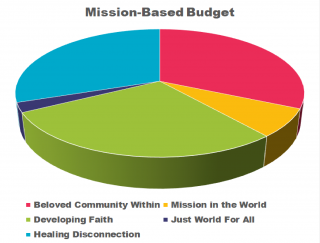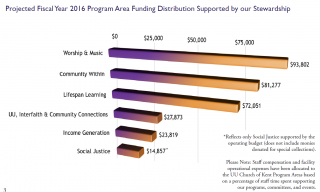Creating a Purpose-Based Budget
We often claim that budgets are moral documents, and that congregational budgets should reflect our values. But line item budgets that include “office supplies, utilities, salary” and other such descriptions don’t show how these line items serve the mission of the congregation. How might congregations re-imagine how they categorize our expenditures?
Many UU congregations have moved to “mission-based,” “values-based” or other purposed-based ways of understanding congregational budgets in their communications to the membership. This isn’t a trick or sleight-of-hand. It’s a way of understanding how a congregation uses its assets and resources to serve its mission that makes sense to the members who care about how the congregation is serving its mission. (Note: Traditional financial statements reflect good accounting practices and should continue to be used by the finance committee, treasurer, bookkeeper, etc.)
How does a congregation do this?

Determine Your Purpose
Determine Your Purpose
Determine the categories of your purpose. Look at your mission and vision statements. Look at your strategic plan. Possible categories might include:
- Creating the Beloved Community Within
- Serving Our Mission in the World
- Developing Liberal Religious Faith
- Making the World Just For All
- Healing Disconnection For All

Pro-Rate Your Resources
Pro-Rate Your Resources
(See this sample budget (pdf) as an example.)
Building
Add up all of the expenses related to the building, e.g. rent, mortgage payments, utilities, custodian/sexton (see staff expenses below), repairs, cleaning supplies, etc.
Then look at the use of the building during the week, and decide what use aligns with which of your mission/purpose categories. (Do not include time when the building is empty.) Determine the percentage of use for each category, and divide your building expense total by that percentage to get the numbers for the mission/purpose budget.
Staff
Add up all of the expenses related to each of your paid staff, including salary, housing (for clergy), taxes, insurance, pension, and professional expenses
Have each of your staff members track their time during a typical month to see what part of the mission/purpose categories they are serving. Determine the percentage of use for each category, and for each staff member, divide each by the total by that percentage to get the numbers for the mission/purpose budget.
Program
Allocate all of your program budget items (e.g. guest speakers, RE curriculum, Share the Plate, etc.) to the proper mission/purpose category.

Communicate!
Communicate!
Now you are ready to communicate how your budget serves your mission! Create charts, graphics, etc. to use on your website, in your stewardship materials and with your potential and new members.

